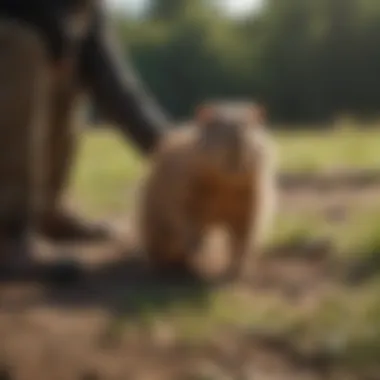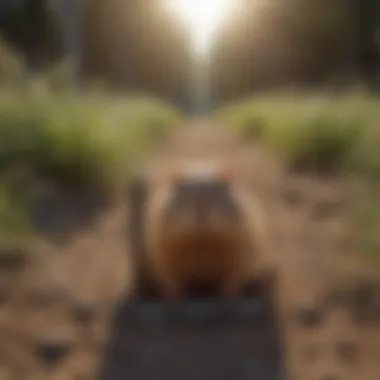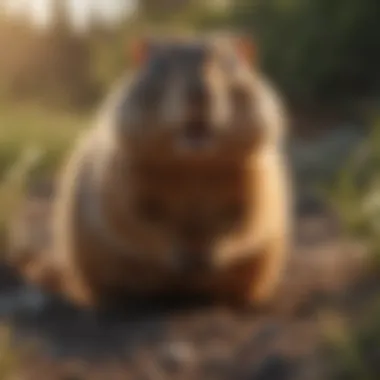Effective Methods for Gopher Control Without Harm


Intro
Gophers can wreak havoc in gardens and yards, causing significant damage to plants, lawns, and root systems. Understanding how to manage their population effectively is crucial for maintaining a healthy outdoor environment. This article explores various strategies for gopher control, focusing on humane and efficient methods. Gardeners and homeowners alike must be aware of how to identify these pests and the signs they leave behind. Furthermore, prevention techniques and eco-friendly control options can mitigate gopher issues without harmful chemicals.
Identification of Common Pests
Description of Common Pests
Gophers belong to the family Geomyidae, primarily known for their burrowing habits. The most common species are the pocket gopher and the southern pocket gopher. These rodents are characterized by their small eyes and ears, robust bodies, and large front teeth. They are primarily active at night, feeding on roots, bulbs, and tubers, which makes them particularly harmful to gardens.
Signs of Infestation
Identifying a gopher infestation involves recognizing specific signs. Homeowners should look for:
- Mounds of soil: Gophers push soil to the surface, creating distinctive fan-shaped mounds. These mounds can range from 6 to 18 inches wide.
- Tunneled areas: Gopher tunnels are typically shallow and can lead to dead patches of grass or plants, indicating consumption of roots underground.
- Chewed plants: Inspecting plants reveals gnaw marks and damaged roots that can indicate gopher activity.
It is essential to act promptly upon noticing the signs of a gopher infestation to prevent further damage to your garden or property.
Prevention Techniques
Home Maintenance Tips
Preventative measures can greatly reduce the likelihood of gopher infestations. Homeowners should consider the following:
- Clean garden spaces: Regularly remove debris and overgrown vegetation, as these provide shelter for gophers.
- Proper irrigation practices: Avoid over-watering, which can attract gophers looking for easy access to roots.
- Use barriers: Installing underground barriers made of hardware cloth can deter gophers from entering specific areas.
Environmental Modifications
Creating an uninviting environment for gophers is vital. Consider:
- Plant selection: Some plants are less appealing to gophers. Consider incorporating plants like lavender or marigolds, which are known to deter these pests.
- Soil management: Maintaining healthy, well-aerated soil can make your garden less desirable to gophers, as they thrive in compacted soil.
Eco-Friendly Pest Control Options
Natural Pesticides
Using natural pesticides is a humane way to manage gopher populations. Products containing castor oil or nematodes can effectively deter gophers without harming the surrounding environment. Regular application throughout the growing season can enhance effectiveness.
Organic Pest Control Techniques
Various organic methods can further assist in controlling gopher populations. Homeowners might consider:
- Traps: Humane traps allow for the capture and relocation of gophers rather than killing them, aligning with eco-friendly practices.
- Bait applications: Using organic baits that appeal to gophers while minimizing harm to other wildlife is advisable.
Intro to Gopher Infestations
Understanding gopher infestations is crucial, especially for homeowners and gardeners. Gophers can cause significant damage to lawns and gardens by uprooting plants, creating tunnels, and disturbing soil structures. For those who care about maintaining the health of their outdoor spaces, recognizing gopher infestations early can save both money and effort.
Understanding Gophers
Gophers are small, burrowing rodents that belong to the family Geomyidae. They are known for their powerful front limbs and large claws, which make them proficient diggers. These animals primarily feed on roots, tubers, and other vegetation, which makes gardens a prime target for their activities. Their burrowing habits can lead to soil erosion and can disrupt the growth of other plants.
Their populations tend to increase in areas where the food supply is abundant, often leading to larger infestations. Notably, gophers are often mistaken for other rodents, such as moles or voles. Each species has unique behaviors and ecological impacts, which is critical to understand for effective control strategies.
Signs of Infestation
Detecting a gopher infestation early can be key to managing their impact. Several indicators can suggest gopher activity:
- Mounds of Soil: Gophers create distinctive mounds as they excavate underground tunnels. These mounds are typically crescent-shaped and can range from a few inches to a foot in diameter.
- Unearthed Plants: If plants appear uprooted or partially dug up, it may be a sign of gopher foraging.
- Burrow Openings: The presence of small, circular holes in the ground can indicate gopher tunnels below.


Gopher activity is often most evident during the spring and fall when they are most active in foraging and breeding. Monitoring these signs regularly helps in taking timely action against infestations.
The Ecological Role of Gophers
Understanding the ecological role of gophers is essential when approaching gopher control. This section sheds light on their presence in local ecosystems, highlighting both their benefits and impacts. By considering these factors, individuals can develop balanced strategies that control gopher populations while appreciating their contributions to soil health and biodiversity.
Benefits to Soil Health
Gophers play a significant role in enhancing soil structure and promoting healthy ecosystems. Their burrowing activities aerate the soil, which increases oxygen availability for plant roots. Here are some specific benefits:
- Soil Aeration: Gophers create extensive tunnel systems that break up compacted soil. This allows for better water infiltration, helping plants access necessary moisture.
- Nutrient Recycling: As gophers dig, they bring nutrients to the surface. This natural process contributes to soil fertility by mixing organic matter with mineral layers.
- Biodiversity Promotion: The tunnels provide habitats for various organisms, including beneficial insects and other small animals, which enhances the local biodiversity.
Taking these factors into account reveals that gophers do much more than cause damage in gardens.
Impact on Local Flora and Fauna
While gophers can disrupt gardens and cultivated land, their activities also have substantial effects on the surrounding flora and fauna. Understanding these impacts is crucial for developing informed control methods. Some notable effects include:
- Vegetation Control: Gophers feed primarily on roots and tubers. As they excavate to reach these food sources, they influence plant communities by favoring certain species over others.
- Creating Microhabitats: The abandoned tunnels left by gophers become microhabitats for various wildlife. Many animals utilize these structures for shelter and nesting, which contributes to ecosystem health.
- Nutrient Cycling: Gophers contribute to the cycling of nutrients by transporting organic materials into their burrows. This process can help establish a nutrient-rich environment that benefits other plants and wildlife.
"Gophers, while often considered pests, play indispensable roles in maintaining the ecological balance within their habitats."
Humane Approaches to Gopher Control
Humane methods of gopher control are significant in maintaining the ecological balance while addressing pest issues. These approaches prioritize the welfare of the animal and aim to reduce their populations without causing harm. This focus is particularly relevant in urban and suburban environments, where residents are increasingly seeking methods that align with ethical standards. By utilizing humane techniques, one not only fosters a healthier ecosystem, but also minimizes potential backlash from animal welfare advocates.
Prevention Techniques
Landscaping Strategies
Utilizing landscaping strategies plays a critical role in gopher control. One effective aspect includes the selection of specific plants. Certain species can deter gophers due to their root structures or volatile oils. For instance, deep-rooted plants often make the soil less appealing for gophers, as they typically prefer loose, easily tunnelable earth.
The key characteristic of landscaping strategies is their proactive nature. They focus on prevention rather than direct removal of gophers. This is why it is a popular choice for homeowners aiming to maintain their gardens without using toxic pesticides or traps. However, implementing these strategies can require significant initial investment and planning. The long-term benefit, however, includes a reduced likelihood of infestation.
Natural Deterrents
Natural deterrents serve as another vital method in humanely managing gopher populations. These are non-toxic substances or methods used to repel gophers. One common example is planting certain types of herbs, such as mint or lavender, known for their strong scents that gophers generally dislike.
The key feature of natural deterrents is their safety for other wildlife and the environment. This makes them beneficial for homeowners interested in eco-friendly pest control solutions. They often provide an additional advantage: the integration of these plants enhances the garden's aesthetic. Despite these advantages, natural deterrents may not produce instantaneous results. A continuous application and monitoring plan is necessary to determine their effectiveness over time.
Using Traps Effectively
Types of Traps
Types of traps can significantly influence the success of gopher control efforts. Commonly used traps include spring traps and baited traps. The choice of trap is crucial and depends on the level of infestation and personal preference.
Spring traps are designed to capture gophers efficiently without causing unnecessary harm. A key characteristic of these traps is their speed of action, which allows for immediate processing of captured animals. This method is often favored by those who wish to prioritize quick and humane removal. However, improper setting can lead to missed captures or injury to non-target species.
Placement Techniques
Effective placement techniques are essential for the success of trapping gophers. Identifying active tunnels is the first step. This can be achieved by looking for fresh mounds of soil or disturbed areas. Once identified, the trap should be placed directly in the tunnel to ensure the highest chance of capture.
The key characteristic of placement techniques is their specificity. This precision makes it a beneficial approach for minimizing unnecessary captures. When done correctly, this method can significantly reduce gopher populations while maintaining ecological balance. On the downside, if traps are not monitored regularly, they may become less effective. Continuously assessing traps is needed to ensure optimal performance.
Chemical Solutions for Gopher Control
Chemical solutions play a pivotal role in the management of gopher populations as they provide a direct and often immediate response to infestations. While humane methods can be effective, certain situations may necessitate the use of chemicals to preserve the integrity of gardens or landscapes. Understanding when and how to use chemical controls is essential. These methods can effectively reduce gopher numbers, protecting crops and ensuring the sustainability of the ecosystem in your garden.
Assessing the Need for Chemicals


Before opting for chemical solutions, it is crucial to assess the level of gopher activity in your area. Not every lawn or garden will require such measures. Observing gopher activity—such as mounds of soil, tunnel entrances, and damaged plants—will help determine if chemical control is necessary.
Factors to consider include:
- Extent of Infestation: Are gophers a minor nuisance, or are they causing significant harm to your garden?
- Type of Landscape: Is it a vegetable garden or a flower bed? Different plants may suffer differently from gopher activity.
- Personal Preference: Some homeowners may prefer more humane methods, while others may seek quicker results.
Understanding these elements will guide you in making an informed decision about whether to integrate chemicals into your gopher control strategy.
Common Chemical Control Methods
Several chemical control methods are prevalent in managing gopher populations. The two primary approaches include poison baits and soil treatments, each having its own unique characteristics and implications.
Poison Baits
Poison baits are one of the most widely used chemical solutions for gopher control. These products typically consist of rodenticide formulated specifically for gophers. A key characteristic of poison baits is their ease of use. Homeowners can simply place the bait in the gophers' tunnels, allowing for effective targeting of the pests.
The benefit of poison baits is their effectiveness; they usually eliminate gophers rapidly once ingested. However, they also pose a disadvantage: there is the potential for non-target animals to inadvertently ingest the poison. Therefore, it is vital to use these baits with caution, ensuring that they are placed safely away from pets and children.
Some important points about poison baits:
- Effective for immediate reduction in gopher populations.
- Requires careful placement to minimize risks to other wildlife.
Soil Treatments
Soil treatments involve applying chemical agents directly to the soil to repel or poison gophers in their burrows. This method has a major advantage that it can treat larger areas than baiting alone. It creates a barrier or toxic environment that discourages gophers from inhabiting certain areas.
The potential disadvantage of soil treatments is their environmental impact. Chemicals can affect soil health and potentially harm beneficial insects or microorganisms. Thus, this method should be used judiciously and in contexts where its benefits outweigh its risks.
Key details to note about soil treatments include:
- Wider coverage than traditional baiting methods.
- Potential negative impacts on soil quality and beneficial organisms.
Important Note: Always read labels and follow instructions when using chemical solutions to ensure safety for yourself, your family, and the environment.
Eco-Friendly Alternatives
Eco-friendly alternatives for gopher control provide a variety of benefits while adhering to sustainable practices. The importance of implementing these methods cannot be overstated, especially in today's context where environmental impact matters. Utilizing humane and natural options not only helps to protect gardens but also preserves the local ecosystem. By avoiding harsh chemicals, homeowners can ensure the health of their plants, soil, and other wildlife.
Using Natural Predators
One effective method to manage gopher populations is to use natural predators. Animals such as owls, hawks, and snakes can significantly reduce gopher numbers in an area. By creating a habitat that attracts these predators, you can establish a balanced ecosystem. This approach encourages a cycle of natural pest control. Moreover, it provides a long-term solution that does not rely on repeated human intervention or harmful substances.
Homemade Remedies
Homemade remedies present another effective option for gopher control. These remedies often use common household ingredients, making them accessible and cost-effective.
Essential Oils
Essential oils are gaining popularity in eco-friendly pest control. Oils such as peppermint and tea tree have strong scents that can repel gophers effectively. Their key characteristic is the powerful aroma they emit, which is unpleasant to these animals. Using essential oils is beneficial because they are non-toxic and do not harm other wildlife. However, the unique feature is their variable effectiveness, as some oils may work better in different environments. Additionally, regular application is necessary to maintain their deterrent effect.
Spicy Mixtures
Spicy mixtures, commonly made from ingredients like cayenne pepper and garlic, can deter gophers quite effectively. The pungent smells and heat promote discomfort for these pests, making it an effective natural repellent. A key characteristic of spicy mixtures is their strong odor, which many animals find intolerable. They are a popular choice due to their availability and low cost. However, the challenge lies in the need for consistent reapplication, especially after rain or watering, to ensure sustained effectiveness.
Legal and Ethical Considerations
The management of gopher populations entails a series of legal and ethical considerations that simply cannot be overlooked. Understanding these aspects is crucial for anyone engaging in gopher control. Local laws may dictate which methods are permissible and which are not, while ethical practices help maintain the balance between human needs and animal welfare.
"Navigating the legal landscape of pest control ensures that actions taken are both justifiable and responsible."


Adherence to regulations protects individuals from potential liabilities that may arise from improper pest control practices. Furthermore, recognizing the ethical implications fosters a sense of stewardship towards the environment and local wildlife.
Understanding Local Laws
It is essential to be aware of local laws regarding gopher control. Regulations can vary significantly between regions, and some methods of control may be restricted or outright banned. Before proceeding with any form of gopher management, consult local authorities or agricultural extensions to get a clear picture of what is allowed.
- Legal Restrictions: Some areas may have laws restricting the use of certain traps or chemical substances.
- Licensing Requirements: In specific jurisdictions, pest control activities may require a license. This ensures that individuals possess adequate training in humane handling and methods.
- Reporting Requirements: In some cases, there might be a need to report gopher infestations to relevant authorities, especially if they threaten agricultural land.
Familiarizing yourself with these laws can prevent legal issues and promote humane and effective gopher management.
Ethical Pest Control Practices
Engaging in ethical pest control practices is vital for several reasons. It underscores the importance of humane treatment of gophers while addressing the challenges they pose. Ethical considerations include the following practices:
- Non-lethal Options: Whenever possible, focus on non-lethal methods such as fencing, natural repellents, and habitat modification.
- Behavioral Understanding: Recognizing gopher behaviors helps in crafting solutions that respect their natural instincts while protecting property.
- Compassionate Trapping: When traps are necessary, choose those that minimize harm and are designed for humane capture. After capturing, transport gophers to suitable environments to minimize suffering.
- Education and Awareness: Teaching others about gopher control and its ethical implications promotes a more conscientious approach among communities.
Adopting a mindset of respect towards gophers and a commitment to ethical practices enriches the discourse on pest control. It fosters a cooperative relationship with nature that benefits humans and wildlife alike. In gopher control, legal awareness and ethical practices work hand in hand to guide effective strategies.
Monitoring and Follow-Up Strategies
Effective gopher control does not end once you implement the chosen methods. The true success of gopher management lies in the monitoring and follow-up strategies utilized to ensure that the problem does not resurface. Here, it is essential to remain vigilant after the initial eradication efforts, as continuous assessment can reveal how well the control measures are working.
Regular monitoring offers numerous benefits. First, it helps to identify any signs of returning gopher populations early. Second, it allows you to gauge the effectiveness of implemented solutions. Third, consistent follow-up ensures that your garden remains safe from potential damage. This proactive approach aids in understanding the habitat and behavior of these pests, refining control tactics as necessary.
Understanding how to effectively monitor and perform follow-ups is crucial for maintaining garden integrity. This section will delve into two key aspects of gopher control: the assessment of control methods and continuous monitoring practices.
Assessment of Control Methods
Evaluating control methods is fundamental in determining their long-term effectiveness. Periodically reviewing your choice of solutions is important. For instance, if you initially used traps or poisons, you should assess if these methods have significantly reduced the gopher population. If not, it may be necessary to modify tactics or introduce new solutions.
Here are few key points to consider during assessment:
- Visual Inspections: Check for fresh mounds of dirt or gumoles as they indicate active gophers.
- Damage Assessment: Look for damage on plants or turf that may point to possible infestations.
- Success Rate: Consider how many gophers have been captured or eliminated successfully in comparison to previous infestations.
- Feedback Loop: Keep a record of methods used successively. This will help in refining your approach over time.
By systematically assessing control methods, you can improve your strategy and underscore that continuous evaluation is key to long-term gopher management.
Continuous Monitoring Practices
Continuous monitoring is critical in the quest to maintain a gopher-free environment. This involves more than just the occasional inspection after initial treatments; it necessitates establishing a routine that includes regular checks of gopher activity.
Here are some practices to adopt for effective continuous monitoring:
- Set a Schedule: Create a timetable for checking for signs of gophers. Weekly visits can help catch issues before they escalate.
- Mark Areas: Keep track of areas previously treated and monitor them closely for new activity. This will help you stay informed about potential problem zones.
- Involve Family: If household members are knowledgeable about gophers, encourage them to report any signs they might notice, fostering a team effort in pest management.
- Utilize Technology: Consider using trail cameras to capture unusual activity in your garden. This non-invasive method can reveal insights into gopher behavior.
Continuous efforts in monitoring will allow you to establish more reliable control, leading to a healthier and more resilient garden. Following these strategies ensures you do not become complacent in the mission of managing gopher populations.
Finale
Addressing gopher control is vital for both maintaining the health of gardens and preserving the local ecosystem. This article has outlined various effective strategies, emphasizing humane and eco-friendly approaches. The significance of understanding gopher behavior and their environmental role cannot be overstated. Readers are encouraged to consider these aspects when managing gopher populations.
Summarizing Effective Methods
In summary, several methods have proven effective in tackling gopher issues:
- Prevention Techniques: Using strategic landscaping and natural deterrents is key. These methods not only minimize the likelihood of infestation but also promote overall garden health.
- Trapping: Employing the right traps, positioned correctly, can significantly reduce gopher populations without causing unnecessary harm.
- Chemical Options: While not always preferred, certain chemical solutions can be employed judiciously, ensuring compliance with local regulations and mindful of environmental impacts.
- Eco-Friendly Alternatives: Utilizing natural predators, such as owls, and homemade remedies, like spicy mixtures, can provide additional layers of control while being mindful of the existing ecosystem.
By integrating these methods, homeowners can maintain a balanced and thriving garden environment.
Future Considerations in Gopher Control
Looking ahead, various considerations will shape gopher control efforts. As urban development continues, gopher habitats are encroached upon, prompting new strategies.
- Research on New Deterrents: Innovation in natural deterrent products may lead to more effective solutions.
- Regulatory Changes: Keeping abreast of changes in regulations regarding pest control chemicals is crucial for compliance and ecological safety.
- Community Involvement: Engaging communities in discussions about sustainable practices will be essential in achieving long-term solutions for gopher management.
Future endeavors in gopher control will emphasize the importance of coexistence and ecosystem health, calling for balanced approaches that respect both human needs and wildlife welfare.







